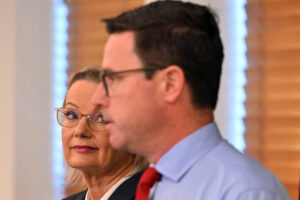It’s no surprise the Business Council, the Australian Industry Group and the National Farmers’ Federation are supporting Labor’s position.
Who says change is impossible in Australian politics? After decades of denial there is finally bipartisan agreement that all of Australia’s coal-fired power stations will shut down, no new ones will be built, and the steady decline of our coal exports has already begun and will not stop. It’s hard to believe it was only March this year when Labor and the Nationals fought the Hunter by-election on who was the most optimistic about coal’s future.
While economic modelling is as overrated as it is misunderstood, the competing models released by the Coalition and Labor do reveal some underlying truths about how both sides see the economy, our politics and even the role of government evolving in the decades ahead.
The Coalition’s modelling of its net zero target captures Scott Morrison’s essence in one giant spreadsheet. Ambitious long run goals, no clear policies to get there, and a devil not so much buried in the detail, but whose existence is simply denied despite all evidence to the contrary. There’s absolutely no doubt that the Coalition’s modelling relies on a carbon price of some sort to drive emissions down, and, true to form, he denies that simple truth, safe in the knowledge that no one is as good at semantic arguments as himself.
The Coalition relied on a computable general equilibrium (CGE) model, which compares the entire economy today with the entire economy in 2050. It assumes that in 2050 emissions would be 85% below their 2005 levels (not 100%); a wide range of new technologies would be invented soon (though no new spending to create such wonderful new machines); and – it needs repeating – a carbon price of $24 to “motivate” (in the words of the modellers) firms to install new technology. It also relies on “offsets” in the form of soil carbon and carbon capture and storage (whose integrity and reliability are already in doubt).
Scott Morrison’s approach to modelling turns convention on its head. Modelling usually revolves around the concept of “cause and effect” – for example, how might a change in taxes impact the broader economy. But the Coalition has simply modelled the effect of emission reductions and has said nothing about what might cause it. Morrison literally relies on “faith” in markets and presents no actual plan for what his government will do differently to drive such enormous change.
Labor’s approach could not be more different. Their starting point is the Coalition’s existing forecasts for Australia’s emissions trajectory for 2030 (not 2050). Rather than model an economy-wide carbon price like the Coalition they have modelled how some very specific energy and transport policies would reduce emissions in specific sectors. Rather than use a “top down” CGE model of how imaginary new policies drive deployment of imaginary new technologies Labor’s “bottom up” modelling focuses on how policy change would drive emissions down.
While neither party’s targets are based on the science of limiting climate change to 1.5C, given that both major parties now support net zero by 2050, the big difference between the 2030 targets is both environmentally and diplomatically significant.
Labor’s 2030 target of a 43% reduction from 2005 levels means a commitment to reduce emissions by 170Mt from the latest levels while Morrison’s 26-28% target range means a cut of only 80Mt. So Labor’s short-term emission reduction target is more than double Morrison’s. More importantly, they have spelled out the actual policies and technologies they’re planning to use to get there.
It’s no surprise that the Business Council of Australia (BCA), the Australian Industry Group (AIG) and the National Farmers’ Federation (NFF) are supporting Labor’s position, while politely ignoring the blancmange of Morrison’s slim plan and modelling fantasy.
The BCA shredded its credibility and split its membership when it called Bill Shorten’s 2019 target “economy-wrecking”. The AIG knows that spending billions paying farmers for “soil carbon” will not help heavy industry reduce emissions. And the NFF knows that while some farmers are happy to take millions for offset credits, the biggest threat to Australian agriculture isn’t climate policy, it is the climate change that comes with the lack of climate policy.
The Australian climate debate is moving fast as the Liberals try to avoid being wedged between the pressure from independent candidates and the petulance of their National party colleagues. This March, the NSW Liberals sacked Malcolm Turnbull from a climate advisory role for admitting we don’t need to build any new coal mines. Imagine where we might be by next March?
Between the Lines Newsletter
The biggest stories and the best analysis from the team at the Australia Institute, delivered to your inbox every fortnight.
You might also like
Full preferential voting means you can’t waste your vote
Full preferential voting is a proud Coalition reform – one that benefits every political persuasion Compulsory voting and full preferential voting make up the backbone of Australian democracy, and protect us from voter suppression and disengagement seen in other countries. We owe both to the parties of the centre-right, what would become the Liberal–National Coalition.
Second-term Albanese Government can escape the Liberal veto
While the exact numbers are not settled, what is clear is that the Albanese Labor Government has won a decisive majority in the Parliament.
Gender parity closer after federal election but “sufficiently assertive” Liberal women are still outnumbered two to one
Now that the dust has settled on the 2025 federal election, what does it mean for the representation of women in Australian parliaments? In short, there has been a significant improvement at the national level. When we last wrote on this topic, the Australian Senate was majority female but only 40% of House of Representatives



